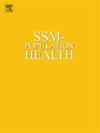Identifying intersectional groups at risk for missing breast cancer screening: Comparing regression- and decision tree-based approaches
IF 3.6
2区 医学
Q1 PUBLIC, ENVIRONMENTAL & OCCUPATIONAL HEALTH
引用次数: 0
Abstract
Malignant neoplasm of the breast was the fifth leading cause of death among women in Germany in 2020. To improve early detection, nationwide breast cancer screening (BCS) programmes for women 50–69 have been implemented since 2005. However, Germany has not reached the European benchmark of 70% participation, and socio-demographic inequalities persist. At the same time, challenges exist to identify groups of women at high risk for non-participation, since it is likely that this is due to disadvantages on multiple social dimensions. This study, therefore, aimed to identify intersectional groups of women at higher risk of not attending BCS by comparing two analytical strategies: a) evidence-informed regression and b) decision tree-based regression. Participants were drawn from the German 2019 European Health Interview Survey (N = 23,001; 21.6% response rate). Two logistic regressions using cross-classification intersectional groups based on relevant PROGRESS-Plus characteristics adjusted by age were built. The evidence-informed approach selected relevant variables based on the literature and the decision tree approach on the best-performing tree. The first identified low-income women born outside Germany, living in rural areas and not cohabiting with their partner at higher risk of never attending BCS (OR = 9.48, p = 0.002), whereas the second, based on a Classification and Regression Tree (61.91% balanced accuracy), determined widowed women living alone, with children, with a partner and children, or in other arrangements, and residing in specific federal states (i.e. Bavaria, Brandenburg, Bremen, Hamburg, or Saarland) (OR = 3.43, p < 0.001). Compared to the evidence-informed regression, the decision tree-based regression yielded higher discriminatory accuracy (AUC = 0.6726 vs AUC = 0.6618) and added relevant nuances in the identification of at-risk intersectional groups, going beyond known inequality dimensions and, therefore, helping the inclusion of under-studied populations in breast cancer screening.

确定有遗漏乳腺癌筛查风险的交叉组:比较回归和基于决策树的方法。
乳房恶性肿瘤是2020年德国妇女死亡的第五大原因。为了改善早期发现,自2005年以来实施了针对50-69岁妇女的全国乳腺癌筛查方案。然而,德国还没有达到70%的欧洲基准,社会人口不平等仍然存在。与此同时,在确定不参与的高风险妇女群体方面存在挑战,因为这很可能是由于多重社会层面的不利因素造成的。因此,本研究旨在通过比较两种分析策略(a)循证回归和b)基于决策树的回归)来确定不参加BCS的高风险交叉女性群体。参与者来自德国2019年欧洲健康访谈调查(N = 23,001;21.6%的回应率)。基于年龄调整的相关PROGRESS-Plus特征,建立了两个交叉分类交叉组的logistic回归。循证方法根据文献选择相关变量,决策树方法选择最佳表现树。第一项研究确定了出生在德国境外、居住在农村地区且未与伴侣同居的低收入妇女从未参加过BCS的风险较高(OR = 9.48, p = 0.002),而第二项研究基于分类和回归树(平衡准确率为61.91%),确定了独居、有孩子、有伴侣和孩子或以其他方式生活、居住在特定联邦州(即巴伐利亚、勃兰登堡、不来梅、汉堡或萨尔州)的丧偶妇女(OR = 3.43, p
本文章由计算机程序翻译,如有差异,请以英文原文为准。
求助全文
约1分钟内获得全文
求助全文
来源期刊

Ssm-Population Health
PUBLIC, ENVIRONMENTAL & OCCUPATIONAL HEALTH-
CiteScore
6.50
自引率
2.10%
发文量
298
审稿时长
101 days
期刊介绍:
SSM - Population Health. The new online only, open access, peer reviewed journal in all areas relating Social Science research to population health. SSM - Population Health shares the same Editors-in Chief and general approach to manuscripts as its sister journal, Social Science & Medicine. The journal takes a broad approach to the field especially welcoming interdisciplinary papers from across the Social Sciences and allied areas. SSM - Population Health offers an alternative outlet for work which might not be considered, or is classed as ''out of scope'' elsewhere, and prioritizes fast peer review and publication to the benefit of authors and readers. The journal welcomes all types of paper from traditional primary research articles, replication studies, short communications, methodological studies, instrument validation, opinion pieces, literature reviews, etc. SSM - Population Health also offers the opportunity to publish special issues or sections to reflect current interest and research in topical or developing areas. The journal fully supports authors wanting to present their research in an innovative fashion though the use of multimedia formats.
 求助内容:
求助内容: 应助结果提醒方式:
应助结果提醒方式:


